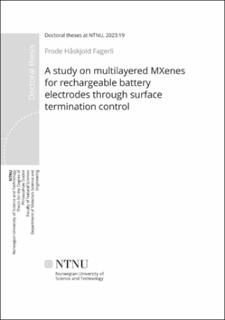| dc.description.abstract | In the transition from fossil fuels to renewable energy sources, the demand for rechargeable batteries is rapidly increasing. To meet this demand, a diversification of battery chemistries will be essential, due to limited abundance of currently used battery materials. In addition to Li-ion batteries (LiBs), rechargeable Mg batteries (RMBs) stand out as a theoretically promising battery chemistry, with the potential to yield high energy batteries based on abundant materials. However, to enable practical RMBs, competitive cathode materials need to be established. Potential candidates may come from the family of two-dimensional transition metal carbides and nitrides known as MXenes, which due to their high electrical conductivity, chemical tunability and ion intercalating properties, have been predicted to yield high intercalation capacities for a range of cations, including Mg-ions. Hence, this study aimed towards evaluating the feasibility of MXenes for rechargeable battery electrodes, and in particular for RMBs.
In the first paper of this work, the feasibility of MXenes as an RMB cathode was investigated by using two different MXene compositions: V2C and Ti3C2. To ensure the possibility for Mg-ion desolvation and migration, these electrodes were galvanostatically cycled in cells with four different electrolytes, and at both low (20 oC) and high (60 oC) temperatures. Still, only minimal capacities were obtained, indicating insignificant reversible Mg-intercalation in the MXene particles. However, by including Li-salts to the electrolyte, significant reversible capacities were measured, demonstrating the functionality of the MXene electrodes. To explain this difference, density functional theory (DFT) calculations were implemented and showed that the migration barriers for Mg-ions were significantly higher than for Li-ions, and that the termination groups attached to the surface of the MXene sheets strongly influenced the intercalation voltages for Li and Mg-ions. Denoted as "T" (i.e. V2CTx), these termination groups usually consist of a mixture of OH, O and F, and the DFT calculations showed that multilayered particles of O-terminated MXenes would be ideal for RMB cathodes. Hence, the focus of this work was directed towards controlling the termination groups of MXenes, and especially towards substituting F- with O-terminations.
In the second and third paper of this work, gas hydrolysation was explored as a post etching treatment to substitute F-terminations in multilayered V2CTx and Ti3C2Tx MXenes, respectively. It was found that successful hydrolysation required a MXene structure with an expanded interlayer spacing, to allow the water molecules to penetrate in between the MXene sheets. For the V2CTx phase, this was achieved by intercalated water molecules from the HF etching step, whereas the Ti3C2Tx phase required preintercalation of cations prior to hydrolysation. For both phases, a F-reduction around 70 % was achieved, demonstrating the greatest F-reduction in multilayered particles reported so far. However, due to challenges of quantifying the remaining terminations (O vs. OH vs. unterminated), the exact composition of the final MXenes remained unclear. Although the F-reduction was clear for both MXene phases, no increase in capacity was observed upon cycling in RMB coin cells. To investigate the termination group’s influence on the electrochemical performance, MXene electrodes were thus cycled in LiBs. This resulted in dissimilar changes for the two MXene compositions. Where the hydrolysed V2CTx phase displayed an enhanced rate capability compared to the pristine MXene, the opposite was true for the Ti3C2Tx MXene. The Ti3C2Tx phase also showed increased average voltages and capacities after hydrolysation, which was not observed for the V2CTx phase. Based on these ambiguous changes in electrochemical performance, and the uncertain composition of the resultant termination mixtures, no clear conclusion on the effect of termination change could be drawn from this work. To ensure controlled formation of O-terminated MXenes, further refining of the hydrolysis method will be required, combined with enhanced termination characterisation.
In addition to the published results, the thesis includes new results on a F-free etching method based on hydrothermal treatment in concentrated NaOH solutions. These etching
conditions allowed for F-free Ti3C2Tx MXene, while the synthesis of other MXene compositions was not successful. Whereas all of the Ti2AlC, Ti2AlN, Ti3AlCN, TiMo2AlC2, Nb4AlC3, Nb2AlC, V2AlC and V4AlC3 MAX phase precursors demonstrated significant oxidation, the former three showed possible signs of some unordered MXene. Further investigation, with optimised etching conditions, is therefore required to conclude about this etching method’s compatibility to form other MXene phases than Ti3C2Tx. Nevertheless, due to the mixture of O- and OH-terminations, this etching method is not ideal for optimal termination control. In comparison, a recently reported etching method, based on Lewis acid etching in molten salts, has enabled synthesis of homogeneously terminated MXenes from different precursors, and with various terminations. | en_US |
| dc.relation.haspart | Paper 1: Kaland, Henning; Hadler-Jacobsen, Jacob; Fagerli, Frode Håskjold; Wagner, Nils Peter; Wang, Zhaohui; Selbach, Sverre Magnus; Vullum-Bruer, Fride; Wiik, Kjell; Schnell, Sondre Kvalvåg. Are MXenes Suitable as Cathode Materials for Rechargeable Mg Batteries?. Sustainable Energy & Fuels 2020 ;Volum 4.(6) s. 2956-2966 © Royal Society of Chemistry 2023 | en_US |
